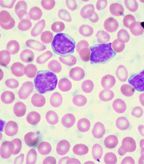ASH: Engineered T-Cell Therapy for Advanced Leukemia Achieves 2-Year Remission Rate
Relapsed or refractory chronic lymphocytic leukemia and acute lymphoblastic leukemia patients have shown durable responses of almost 2 years to a novel T-cell engineering technique developed at the University of Pennsylvania Perelman School of Medicine in Philadelphia.
Relapsed or refractory chronic lymphocytic leukemia (CLL) and acute lymphoblastic leukemia (ALL) patients have shown durable responses of almost 2 years to a novel T-cell engineering technique developed at the University of Pennsylvania Perelman School of Medicine in Philadelphia. The results of a 10-patient study were reported at the American Society of Hematology (ASH) meeting in Atlanta. The T-cell infusion technique can “induce potent and sustained responses for patients with advanced, refractory and high-risk CLL and relapsed refractory acute lymphoblastic leukemia,” said the study authors.

Peripheral blood film from a 70-year-old woman with an absolute lymphocyte count of 41,000/uL; source: Ed Uthman, Wikimedia Commons
The technique is still relatively new, but is the only promising treatment that has the potential to cure patients besides bone marrow transplants. While bone marrow transplants can be highly effective, they carry an approximately 20% risk of mortality and require a long hospital stay.
“We now show in a larger number of patients that this therapy is indeed potent and effective for the majority of patients,” Porter told Cancer Network. Thus far, 9 of 11 patients who underwent the therapy have responded, 7 of 9 patients with CLL, and both patients with ALL. One of the ALL patients, featured this week in the New York Times, is a 6-year-old girl who has had a remarkable recovery.
“Remissions can last more than two years from follow-up studies of our initial patients,” said Porter. “Toxicity can be significant, but we believe there is an effective management strategy using anticytokine therapy. We also show that this therapy can induce remissions not just for CLL, but for patients with refractory ALL.”
The patients received infusions of their own T cells that had been genetically engineered to express a chimeric antigen receptor (CAR) on the their surface that can bind to the CD19 protein. A patient’s blood is drawn and T cells are isolated and genetically modified to express the receptor for CD19, a protein expressed on lymphoma and leukemia cells, but also includes normal B cells. These engineered T cells are then infused back into the patient and attack only CD19-expressing cells, which limit systemic toxicities. The CARs also make cytokines that signal other T cells to multiply and attack the tumor.
The efficacy of this technique in three CLL patients was originally published in the New England Journal of Medicine, two patients went into complete remission. The data presented at ASH by David L. Porter, MD, of the hematology/oncology division at the University of Pennsylvania now shows longer-term outcomes from 10 patients treated with CD19 CAR T cells. The 10 patients included 9 relapsed, refractory CLL patients older than 65 who had received a median of five previous therapies, a 7-year-old with relapsed, refractory ALL. Three of the CLL patients and the ALL patient achieved a complete response and have not had a relapse. Two CLL patients had a partial response for 3 and 5 months and three patients did not respond at all.
Beyond Bone Marrow Transplants
Patients who responded to the treatment had various degrees of what is known as a cytokine release syndrome (CRS) characterized by fever, nausea, hypoxia, transient hypotension, and anorexia. The CRS correlated with spikes in the cytokine IL-6 level, and although steroid treatment was partially beneficial, the IL-6 receptor antagonist, tocilizumab was effective in resolving hypoxia, hypotension, and fever in these patients.
“Though we have found our therapy is associated with significant toxicity, it is very different than bone marrow transplants,” said Porter. “For one, the side effects seem to transient. In bone marrow transplant patients, there remains a risk from long-term immune suppression and slow immune reconstitution, as well as long-term side effects, symptoms, and risks from graft-vs-host disease.” The side effects with CAR appear earlier and resolve without long-term risks, according to Porter. Additionally, the chemotherapy used is more tolerable compared to that used with transplantation. “We have treated patients well beyond the upper age limit that is practical for bone marrow transplants,” said Porter.
University of Pennsylvania researchers are about to open a larger trial for patients that will determine an optimal treatment dose.
A Potential Diagnostic Signature
In another study presentation, Michael Kalos, PhD, of the University of Pennsylvania Perelman School of Medicine shows that this T-cell engineered technique can result in persistence of the CD19-expressing T cells. Unlike previous infused cell studies which have demonstrated only transient expansion of infused cells and limited antitumor activity, the CD19-engineered cells were persistent long term in patients who achieved a complete response in the study.
In contrast to nonresponding patients, those that responded had elevated cytokines including IL-6 and IL-8. These higher levels of cytokines correlated well with division of CD19-expressing T cells and elimination of B cells. The authors suggest that this cytokine profile could be used to track efficacy of treatment.
Trials in other tumor types, including solid tumors are ongoing. This research is funded by the Leukemia & Lymphoma Society, the Alliance for Cancer Gene Therapy, and the National Institutes of Health. In August of this year, Novartis and the University of Pennsylvania announced a global research and a licensing agreement that gives Novartis exclusive licensing rights to the technology worldwide. Novartis is also contributing $20 million to build a Center for Advanced Cellular Therapies on the University of Pennsylvania campus that aims to develop and manufacture adoptive T-cell immunotherapies such as the CAR technology.
Newsletter
Stay up to date on recent advances in the multidisciplinary approach to cancer.
Highlighting Insights From the Marginal Zone Lymphoma Workshop
Clinicians outline the significance of the MZL Workshop, where a gathering of international experts in the field discussed updates in the disease state.